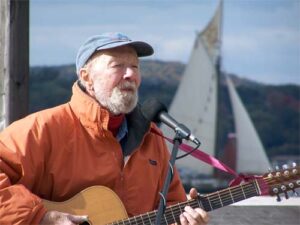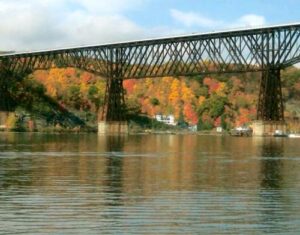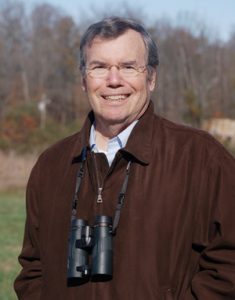Does New York Have an Environment?
 Stephen P. Stanne, Roger G. Panetta, Brian E. Forist and Maija Liisa Niemistӧ,
Stephen P. Stanne, Roger G. Panetta, Brian E. Forist and Maija Liisa Niemistӧ,
The Hudson: An Illustrated Guide to the Living River, 3rd edition (New Brunswick: Rutgers University Press, 2021).
Growing up in New York, I was always puzzled that the Hudson River was not as famous or fabled as the Mississippi, the Missouri, the Rio Grande, or even the Ohio. The Hudson: An Illustrated Guide restores the river that flows by Manhattan to its rightful place at the beginning of European exploration, as a center of ocean travel and trade, an essential ecosystem that gave rise to American environmentalism, and a body of water being renewed and restored despite the widespread perils to our planet.
This is an important and impressive feat since the Hudson, as well as New York harbor and its ocean gateway to the world, has long been overshadowed by “the City,” the center of American capitalism and its canyons of skyscrapers.
One in every ten families in the United States lives within two hours of New York City. Its iconic skyline is instantly recognizable worldwide. The Big Apple is the epitome and epicenter of sophisticated urban life in America. “Start spreadin’ the news…” croons Frank Sinatra in his pop paean to New York. “You’re big, your loud, your tough,” “belts billionaire Daddy Warbucks in Annie.

 Caught in a traffic jam or amidst New Year’s celebrants in Times Square, it is hard to imagine that NYC is part of an ecosystem or any environment at all. Harder still to grasp that New York is one of the world’s great ocean cities and that its harbor and the Hudson River that feeds it have seen ships crossing the Atlantic for some 600 years since Verrazano was the first European explorer to reach New York, describing its harbor and the native people who had been living there for 10,000 years. Henry Hudson came in the Half Moon nearly a century later (1609) and, searching for the fabled passage to Asia, sailed up the great river now named after him that also gives the title to this lushly-illustrated, compact compendium of history, culture, and ecological information.
Caught in a traffic jam or amidst New Year’s celebrants in Times Square, it is hard to imagine that NYC is part of an ecosystem or any environment at all. Harder still to grasp that New York is one of the world’s great ocean cities and that its harbor and the Hudson River that feeds it have seen ships crossing the Atlantic for some 600 years since Verrazano was the first European explorer to reach New York, describing its harbor and the native people who had been living there for 10,000 years. Henry Hudson came in the Half Moon nearly a century later (1609) and, searching for the fabled passage to Asia, sailed up the great river now named after him that also gives the title to this lushly-illustrated, compact compendium of history, culture, and ecological information.
Stephen Stanne and colleagues wanted this new edition to reach out more broadly to general readers, as well as to courses and classrooms concerned with American rivers. They have succeeded admirably. Though authoritative, the writing is swift and sure with sources and notes relegated to the back matter, the illustrations and photographs appealing and apropos.
 Much of critical American history is in The Hudson, as is the development of our environment movement – from the the Hudson River Valley school of Romantic nature art, to the preservation of the Adirondacks, to the conservation leadership and legislation of Teddy Roosevelt.
Much of critical American history is in The Hudson, as is the development of our environment movement – from the the Hudson River Valley school of Romantic nature art, to the preservation of the Adirondacks, to the conservation leadership and legislation of Teddy Roosevelt.
The birth of the modern environment is centered around New York as well, from the battles against DDT begun by Marjorie Spock and amplified by Rachel Carson in The New Yorker, to the founding of the Environmental Defense Fund and Natural Resources Defense Council, on through the struggle against the toxic pollution of the Hudson from PCBs General Electric dumped in the Hudson that was been carried out by folksinger Pete Seeger and his sloop, the Clearwater. After Seeger’s death the battle as continues with the environmental non-profit, Hudson River Sloop Clear Water, Inc., that has helped produce The Hudson.

 Attention to the Hudson and New York Harbor in recent years is helping to restore our understanding of New York’s environment as more than Wall Street or Broadway. The Hudson will help accelerate this trend. Stanne and company remind us that New York’s waterfront piers, from which, in the 1950s, I watched relatives board majestic ocean liners bound for vacations or study in Europe and the Middle East, have been rebuilt and revived as popular waterfront parks and promenades. The same is true for recent innovations like the Walkway Across the Hudson that allows tourists and pedestrians to take in the splendors of the Hudson River valley.
Attention to the Hudson and New York Harbor in recent years is helping to restore our understanding of New York’s environment as more than Wall Street or Broadway. The Hudson will help accelerate this trend. Stanne and company remind us that New York’s waterfront piers, from which, in the 1950s, I watched relatives board majestic ocean liners bound for vacations or study in Europe and the Middle East, have been rebuilt and revived as popular waterfront parks and promenades. The same is true for recent innovations like the Walkway Across the Hudson that allows tourists and pedestrians to take in the splendors of the Hudson River valley.
 Perhaps most remarkable of all is that the authors of The Hudson have given us an astounding assemblage of wildlife that inhabits the air, water and shores of the mighty river that created and defines New York. How and where beaver, eagles, striped bass, sturgeon, shore birds, and more live in this ecosystem and why they should be protected makes this an extremely instructive and useful guide for students of biology and environmental studies, as well as for those of us seeking respite from the drumbeat of urban living.
Perhaps most remarkable of all is that the authors of The Hudson have given us an astounding assemblage of wildlife that inhabits the air, water and shores of the mighty river that created and defines New York. How and where beaver, eagles, striped bass, sturgeon, shore birds, and more live in this ecosystem and why they should be protected makes this an extremely instructive and useful guide for students of biology and environmental studies, as well as for those of us seeking respite from the drumbeat of urban living.
 But The Hudson does not shy away from the dangers to the Hudson’s environment, nor should it, given the devastation wrought on New York by Super Storm Sandy, or the increasing flooding of the city’s familiar subway system. The concluding sections offer detailed depictions of the causes and consequences of climate change and what we all must do to mitigate its dangers, as well as suggestions for involvement in organizations like WEACT concerned with environmental justice and the unequal impact of pollution and climate change on New York’s poor and vulnerable. For a single, sumptuous, slim volume that will spark ecological consciousness and restore the pride of place of New York’s Hudson River, The Hudson: An Illustrated Guide to the Living River, 3rd edition, is the place to dive in.
But The Hudson does not shy away from the dangers to the Hudson’s environment, nor should it, given the devastation wrought on New York by Super Storm Sandy, or the increasing flooding of the city’s familiar subway system. The concluding sections offer detailed depictions of the causes and consequences of climate change and what we all must do to mitigate its dangers, as well as suggestions for involvement in organizations like WEACT concerned with environmental justice and the unequal impact of pollution and climate change on New York’s poor and vulnerable. For a single, sumptuous, slim volume that will spark ecological consciousness and restore the pride of place of New York’s Hudson River, The Hudson: An Illustrated Guide to the Living River, 3rd edition, is the place to dive in.
— Bob Musil
 Bob Musil, President & CEO of the Rachel Carson Council co-leads RCC’s Coasts and Ocean Program with Audrey Magnuson. He grew up in Manhattan and on Long Island. Dr. Musil is the author of Hope for a Heated Planet: How Americans Are Fighting Global Warming and Building a Better Future (Rutgers University Press, 2009) and a forthcoming new edition of Rachel Carson’s Under the Sea-Wind.
Bob Musil, President & CEO of the Rachel Carson Council co-leads RCC’s Coasts and Ocean Program with Audrey Magnuson. He grew up in Manhattan and on Long Island. Dr. Musil is the author of Hope for a Heated Planet: How Americans Are Fighting Global Warming and Building a Better Future (Rutgers University Press, 2009) and a forthcoming new edition of Rachel Carson’s Under the Sea-Wind.







